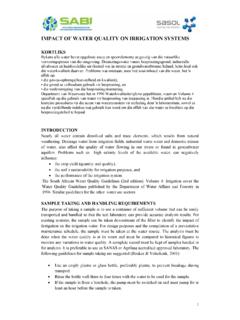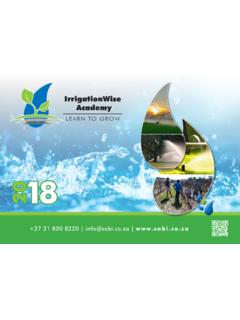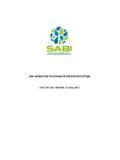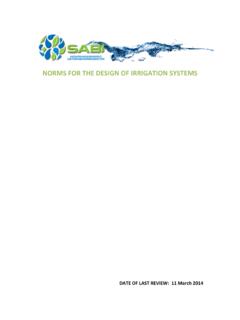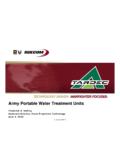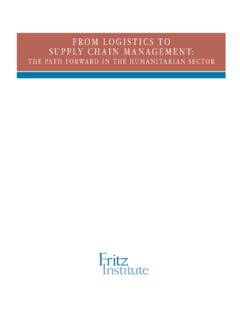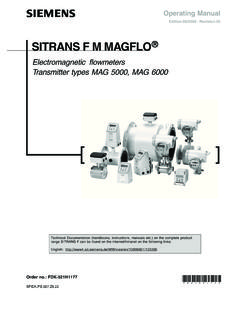Transcription of Water use and Water transfers – Part 1 - Sabi
1 Water use and Water transfers part 1 Francois van der Merwe, Chief Engineer, Directorate Water Abstraction and Instream Use, Department of Water Affairs, PretoriaIntroDUCtIonWater law in South Africa is neither simple nor straight-forward. After 12 years with the new National Water Act (Act 36 of 1998) (NWA) there is still an enormous amount of uncertainty amongst Water users of what their rights and obligations are in terms of this Act and how it will affect their future plans for further competition for Water is constantly on the increase and resources are become even more stressed; while simultaneously quality of available Water is progressively deteriorating; therefore appropriate laws and the strict but fair implementation of such laws are needed in order to manage this limited Water resource for the best benefit of the whole oF Water lAW In sAIn the pre-colonial era, African customary rule governed the use of Water , which means that Water rights only came up when a group felt that another group was unfairly encroaching onto its Water resources.
2 During the 17th and 18th centuries, first the Dutch East India Company governed parts of the current South Africa, and introduced Water management principles based on Roman-Dutch civil law. This era was followed by the British occupation of South Africa during the 19th century with a further change in the emphasis of Water 1910, independence from the British was obtained. New legislation was a combination of English common law and Roman-Dutch civil law and also included aspects of customary law. The Irrigation and Conservation of Waters Act (Act 8 of 1912) first made a distinction saBI Magazine regularly receives enquiries from irrigation designers and producers regarding aspects of the national Water act. this article is the first in a series of two that have been written to clarify some of the common issues normal flow and surplus flow as well as between public Water and private Water . This Act mainly dealt with use of Water for was followed by the Water Act (Act 54 of 1956) in which the distinction between the public and private Water from the 1912 Act was further refined.
3 The 1956 Act entrenched and refined riparian rights but partially brought back dominus fluminis from the Roman-Dutch civil law, meaning that the State has the power to control the usage of Water in the rivers, through the power of the Minister to declare government Water control areas where Water could also be allocated to non-riparian PrIorItIEsIn 1992, the Dublin Principles were adopted by the United Nations in Dublin, Ireland. These stated that: Principle 1: Fresh Water is a finite and vulnerable resource, essential to sustain life, development and the environment. Principle 2: Water development and management should be based on a participatory approach, involving users, planners and policy-makers at all levels. Principle 3: Women play a central part in the provision, management and safeguarding of Water . Principle 4: Water has an economic value in all its competing uses and should be recognized as an economic emphasis of Principle 4 of the Dublin Principles on the economic value of Water rather than Water as a universal right, has been and still is highly contested in many circles.
4 Water legislation introduced by different countries since 1992 has mostly adopted a compromise between the two viewpoints, like in SA. nAtIonAl Water ACt (ACt 36 oF 1998) (nWA)The NWA was introduced in South Africa on 1 October 1998. In Chapter 4 of the NWA the tHE PUrPosE oF tHE nWA According to section 2 this is to ensure that the nation s Water resources are protected, used, developed, conserved, managed and controlled in ways which take into account the following: Meeting the basic needs of present and future generations Promoting equitable access to Water Redressing the results of past racial and gender discrimination Promoting the efficient, sustainable and beneficial use of Water in the public interest Facilitating social and economic development Providing for growing demand for Water use Protecting aquatic and associated ecosystems and their biological diversity Reducing and preventing pollution and degradation of Water resources Meeting international obligations Promoting dam safety, Managing floods and droughts.
5 Basis of regulating Water use in South Africa is provided and the legal requirements of Water use authorisation are described in detail. Some of the important deviations from the 1956 Water Act which are applicable to the irrigation sector, are as follows: No permanent right to use Water exists any more and all Water use authorisations have a limited duration, except for the Reserve, which is a permanent allocation to sustain the environment s Water resources and to provide for basic human needs. Eleven separate Water uses have been identified which need specific authorisation. The concept of private Water has been abolished, and surface Water and groundwater has the same status everywhere. Nobody may use Water unless it is exercised as a: o Schedule 1 Water use (taking Water for reasonable domestic use in the person s household, for small gardening not for commercial purposes and for watering of animals grazing on the land);o as an existing lawful Water use ( Water use allowed to proceed under the same conditions and obligations as in the past between October 1997 and September 1999 until compulsory licencing will be announced in a catch-ment-by-catchment manner);o in terms of a general authorisation (for specific relatively small uses within the limitations provided in Government Gazette Notice 399 of 26 March 2004, extended to 30 June 2012); oro according to a licence issued for that use (if none of the first three cases apply).
6 Water UsEs (sECtIon 21 oF tHE nWA)At least five of the eleven Water uses as defined by section 21 are normally exercised in ag-riculture, namely:(a) taking Water from a Water resource; (b) storing Water ;(c) impeding or diverting the flow of Water in a watercourse;(f) discharging waste or Water containing waste into a Water resource through a pipe, canal, sewer, sea outfall or other conduit; (i) altering the bed, banks, course or characteristics of a watercourse. section 21(a): taking Water from a Water resource A Water resource includes among others a river, stream, dam, weir, lake, pan, spring, aquifer, wetland or any surface 21(a) taking of watersection 21(b) storing of waterCAsE stUDy 1: A person bought a farm in an area outside of any irrigation scheme, where no irrigation was exercised during the last few years, but he was told that 12 ha of cash crops have been irrigated for many years under sprinkler irrigation until around 2003. The new owner intends to plant 16 ha of citrus under drip irrigation.
7 How would he know whether his irrigation will be lawful or whether he must apply for a licence?The first possibility that he may investigate is whether the 12 ha sprinkler irrigation did, in fact, qualify as existing lawful Water use as defined in the NWA, and in order to do that he needs to apply the rule provided in section 32, which requires that the irrigation should have taken place during the period 1 October 1997 and 30 September 1999 and it was lawful under the 1956 Water Act or other authorisation. If it qualifies as existing lawful Water use, the new farm owner may carry on using the volume of Water per year that was used during that period for the 12 ha sprinkler irrigation. If that volume is enough to irrigate his intended 16 ha citrus under drip irrigation, he may proceed without any further approval from the Department. If that volume is not enough, he needs to check whether the existing general authorisation (contained in Government Gazette Notice 399 of 26 March 2004, as extended to 30 June 2012) does allow him to take the additional amount, and if not, he must apply for a licence, but only for the additional amount.
8 Canals, pipelines or off-channel dams having no catchments are not Water resources, but the Water must have been taken from a Water resource in the first place, and that taking of Water from the Water resource need to be authorised through the NWA before the Water may be taken. In the case of taking Water from a Water resource, the Water use takes place at the point where the Water is taken from the resource and not where it is utilised for a specific purpose, like : H schoemanExpansion of irrigation areas can be determined using historical satellite imagery19982003 CAsE stUDy 2: A person has an entitlement to pump 150 000 m3/year for irrigation from a river flowing through his farm, but he considers building a dam in order to increase his assurance of supply. He determines that a dam that stores 50% of his allocation will be adequate to ensure that he would then not need to pump from the river during the low-flow he discussed his request with the Department s Regional Office, he decides to apply for a section 21(b) Water use licence for an off-channel dam for 80 000 m3.
9 He is also told that he must apply for a section 21(i) Water use licence, namely for altering the bed, banks and characteristics of a watercourse by building a dam. He must then also approach the dam safety Office of the Department in order to find out whether he will need a dam safety licence apart from the section 21(b) Water use licence. Together with his Water use licence application, he must supply the Department with proof of the lawfulness of his taking of 150 000 m3/year from the river. For that he will normally be required to apply in terms of section 35 of the NWA for the verification of his existing lawful Water use. After verification has been done, any relevant conditions that existed in terms of the taking of the Water (like a possible limitation on pumping during certain months), may be included as conditions in the draft licence for the storing of the Water . In considering the approval of the application, the Minister should also consider all other relevant factors as required in section 27(1) of the NWA.
10 The dam safety Office will also not approve the relevant dam safety licence to construct the dam before the section 21(b) Water use licence has been issued. He will therefore need licences for section 21(b) and (i) Water uses, as well as a dam safety licence before he may 21(b): storing Water The storage of Water should be authorised from a Water use perspective and the storage facility from Dam Safety perspective. Any dam with a wall more than 5 metres high, and which is capable of storing more than 50 000 m3, may pose a dam safety risk, needs to be classified and may need a Dam Safety licence to construct and to impound, in addition to the Water use 21(c): Impeding or diverting the flow of Water in a watercourse Causing an obstruction to the flow of Water in a watercourse or diverting some or all of the flow from a watercourse, is a Water use which require an 21(f): Discharging waste or Water containing waste into a Water resource through a pipe, canal, sewer or other conduit Common examples of this Water use are waste released into a stream, river or dam at a discharge point, such as wastewater from food processing or factories, or run-off from 21(i).
